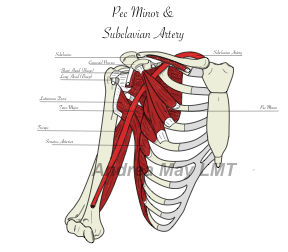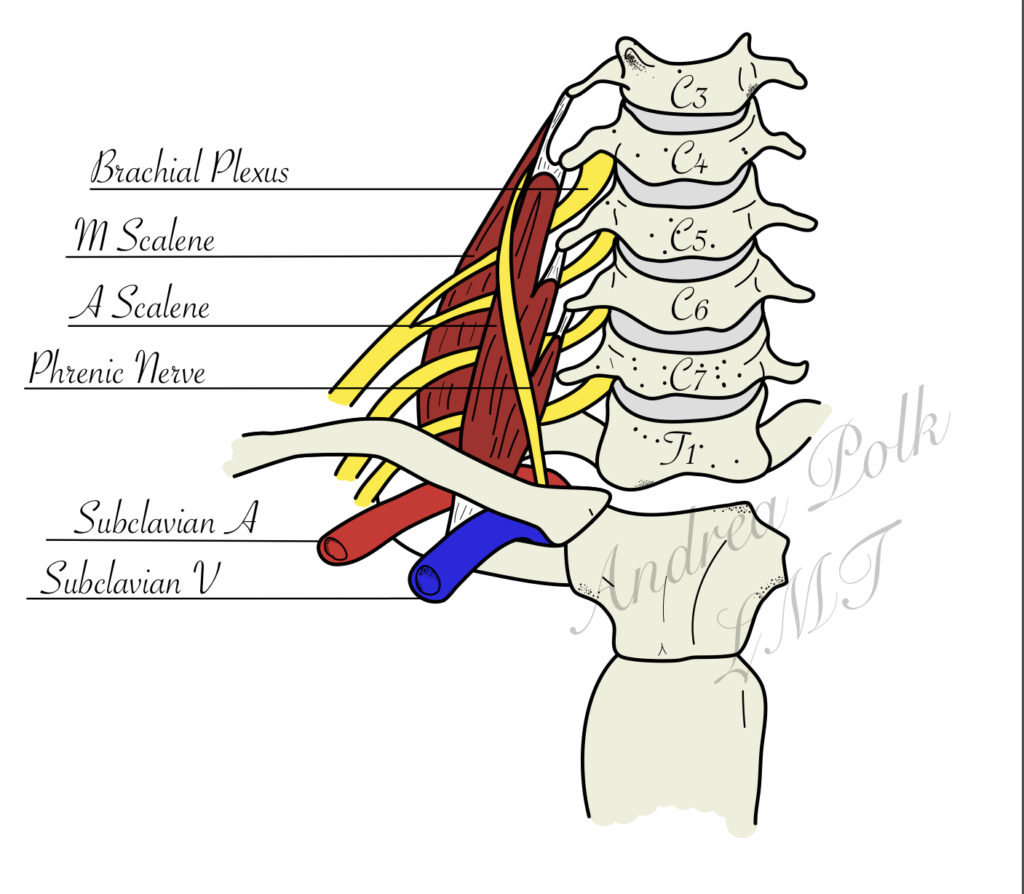Arms Falling Asleep? Did You Know Scalenes and Pectoralis Minor Occlude Blood-flow?
Arms Falling Asleep? Did You Know Scalenes and Pectoralis Minor Occlude Blood-flow?
The sensation of arms falling asleep, often accompanied by tingling or numbness, can be attributed to various factors, and one notable contributor is the compression or occlusion to our structures that transport blood flow. In particular, the scalene muscles and the pectoralis minor play a significant role in potential blood flow restriction through the subclavian artery, leading to the uncomfortable sensation of limbs “falling asleep.” In this article, we will delve into the anatomy, mechanics, and potential solutions related to arms falling asleep, focusing on the involvement of the scalenes and pectoralis minor muscles.
1. Understanding the Anatomy:
The subclavian artery, a major blood vessel that supplies blood to the arms, passes through a narrow space between the scalene muscles in the neck. Additionally, the pectoralis minor, a muscle located in the chest, can contribute to compression of the subclavian artery.
- Scalene Muscles: The scalene muscles, including the anterior, middle, and posterior scalenes, are situated on either side of the neck, forming a passage through which the subclavian artery travels.
- Pectoralis Minor: The pectoralis minor, a triangular muscle located in the upper chest, has an attachment near the shoulder, potentially affecting the subclavian artery as it passes beneath.


2. Mechanism of Blood Flow Occlusion:
When the scalene muscles or the pectoralis minor become tight or shortened, they can compress the subclavian artery, leading to a reduction in blood flow to the arms. This compression may result from poor posture, muscular imbalances, or repetitive movements.
- Forward Head Posture: Forward head posture, common in those who spend extended periods at computers or desks, can contribute to tightness in the scalenes and pectoralis minor, increasing the risk of compression.
- Repetitive Movements: Activities that involve repetitive overhead movements or prolonged elevation of the arms may exacerbate muscular tension, contributing to blood flow restriction.
3. Symptoms of Blood Flow Occlusion:
Compression of the subclavian artery by the scalenes and pectoralis minor can manifest in symptoms such as tingling, numbness, and the sensation of arms falling asleep. These sensations may occur more frequently when the arms are elevated.
- Tingling and Numbness: Reduced blood flow to the nerves in the arms can result in tingling or numbness.
- Elevated Arms: Symptoms may intensify when the arms are raised, such as during activities like reaching overhead or carrying objects.
4. Soft Tissue Therapy for Relief:
Soft tissue therapy plays a crucial role in addressing tightness and restrictions in the scalenes and pectoralis minor, aiming to alleviate blood flow occlusion and relieve the symptoms of arms falling asleep.
- Myofascial Release: Techniques such as myofascial release help release tension in the fascia surrounding the scalene and pectoralis minor muscles.
- Trigger Point Therapy: Specific trigger points in these muscles may be identified and targeted to promote relaxation.
5. Stretching and Strengthening Exercises:
In addition to soft tissue therapy, incorporating stretching and strengthening exercises into a comprehensive routine can help prevent the recurrence of arms falling asleep by promoting flexibility and balance.
- Scalene Stretching: Gentle stretches for the scalene muscles can help reduce tightness and improve range of motion.
- Pectoralis Minor Stretching: Stretching exercises for the pectoralis minor can alleviate tension in the chest and contribute to improved blood flow.
6. Postural Correction:
Addressing the root cause often involves correcting poor posture and addressing contributing factors that lead to tightness in the scalenes and pectoralis minor.
- Ergonomic Considerations: Individuals with desk jobs should pay attention to ergonomic setups to prevent forward head posture.
- Postural Awareness: Encourage awareness of posture during various activities to avoid prolonged positions that contribute to muscular imbalances.
7. Seeking Professional Guidance:
Individuals experiencing persistent symptoms of arms falling asleep should seek professional guidance from healthcare providers, including soft tissue therapists, physical therapists, and physicians.
- Diagnostic Assessment: A comprehensive assessment can help identify the specific factors contributing to blood flow occlusion and guide the development of an effective treatment plan.
- Collaboration with Other Specialists: Collaboration with other healthcare professionals may be necessary to address any underlying structural issues or medical conditions.
8. Conclusion: Empowering Healthy Blood Flow
Understanding the role of the scalenes and pectoralis minor in blood flow occlusion sheds light on potential causes of arms falling asleep. By incorporating soft tissue therapy, stretching, strengthening exercises, and postural correction into a holistic approach, individuals can empower themselves to maintain healthy blood flow, reduce symptoms, and promote overall well-being.
Individuals experiencing recurrent sensations of arms falling asleep are encouraged to consult with healthcare professionals to determine the underlying causes and develop a tailored treatment plan. Soft tissue therapists, in particular, can play a crucial role in addressing muscular imbalances and promoting optimal blood flow for improved comfort and functionality. If you have any questions, don’t hesitate to reach out to us.